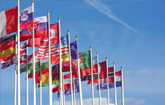One Year Later: Refocusing the World's Attention on Haiti's Children
Americans were largest donors to UNICEF 's Haiti Emergency Appeal - New Call for Year of Service to Haiti's children
NEW YORK, Jan. 7, 2011 /PRNewswire-USNewswire/ -- One year after the devastating January 12 earthquake shook their fragile lives, Haiti's 4 million children continue to suffer from inequitable access to basic water, sanitation, healthcare, and education services and protection from disease, exploitation, and unsanitary conditions, UNICEF said today.
Today, more than 1 million people – approximately 380,000 of whom are children – still live in crowded camps. The relief and recovery efforts of Haitians and the international community have been extraordinary. Nonetheless, the United Nations children's agency noted in its report "Children in Haiti: One Year After - The long road from relief to recovery" issued today in recognition of the anniversary, that the recovery process is just beginning.
"Children in particular suffered and continue to suffer enormously because of successive emergencies experienced in 2010, and they have yet to fully enjoy their right to survival, health, education, and protection," said Ms. Francoise Gruloos-Ackermans, UNICEF Haiti Representative.
"Haiti poses huge institutional and systemic issues that predated the earthquake, and that require more than an emergency response to resolve. This places even more emphasis on the need for organizations such as UNICEF to focus on developing and reinforcing structural interventions that will adequately prepare this country and its inhabitants for the future," Gruloos-Ackermans added.
Responding to the challenges of successive humanitarian emergencies requires commitment and investment in sustainable solutions for Haiti's people. Water, sanitation and hygiene were on the decline prior to January 12, with only 19 percent of people having access to basic sanitation facilities in 2006, down from 29 percent in 1990.
In response, UNICEF provided more than 11,300 latrines serving over 800,000 people. Every day, over 600 latrines are desludged as part of UNICEF's ongoing efforts to maintain safe sanitation standards. While challenges remain in both water and sanitation, UNICEF is working to help implement sustainable solutions that include investing in water systems and focusing on community-led sanitation.
In the immediate aftermath of the earthquake, UNICEF, WHO and partners conducted emergency vaccination campaigns immunizing 2 million children against preventable diseases such as polio, diphtheria, and measles. A distribution of 360,000 insecticide-treated bednets reached more than 163,000 households in the malaria-endemic southern coastal regions.
At the height of the emergency response, UNICEF and partners trucked a daily average of 8.3 million liters of safe water to approximately 680,000 people. With the ongoing cholera outbreak, UNICEF is providing more than 10.9 tons of chlorine and over 45 million water purification tablets to ensure safe water for 3 million people in the capital city and the surrounding towns.
The UNICEF-led Child Protection Interagency Working Group helped register and reunite children who were separated from their families and worked with national and international partners to put in place 369 Child-Friendly-Spaces for close to 95,000 children across earthquake-affected areas. UNICEF also initiated prevention and response activities to gender-based violence, and, importantly, on child trafficking. In addition, to date, 4,948 children have been registered and 1,265 have been reunited.
UNICEF and partners helped establish schools, procured tents and educational materials and allocated resources so that 720,000 children could resume their lessons, and in some cases, start school for the first time. Nonetheless, more than half of Haiti's children do not attend school and school construction continues to be hampered by rubble clearing and land tenure issues.
The earthquake highlighted the deeply rooted structural problems faced by Haiti's children, including chronic malnutrition, which affects one in three children under five years of age. UNICEF worked with partners to deliver nutritional supplements to address particular needs of infants and their mothers. By mid-year, a network of 107 "baby friendly tents" was fully operational, providing nutritional advice and counseling for mothers and children, including a safe space to breastfeed. To date, more than 102,000 children and 48,900 mothers have been reached through these services with nutrition counseling and information.
The Road Ahead for Haiti's Children
"Despite all that has been accomplished thus far we know that the job is far from over," said Caryl Stern, president and CEO of the U.S. Fund for UNICEF, which is the largest donor organization to UNICEF for its Haiti emergency response having raised more than $70 million in response to the emergency. "TV cameras come and go, but UNICEF will not leave Haiti's children. We will be there for the long road ahead."
"As long as a single child lives in a tent, or goes to bed without enough food, or gets sick from a preventable disease, or is denied the chance to go to school – as long as any child in Haiti needlessly suffers – we still have work to do, which is why we are asking for those with strong voices to become advocates for Haiti's children," added Stern.
In the effort to keep the needs of children central to Haiti's long-term recovery, the U.S. Fund for UNICEF is launching Haiti 365: Be Their Voice at www.UNICEFHaiti365.org as a platform to enable the U.S. public to renew their commitment to Haiti's children and advocate on their behalf. There is a profound opportunity right now to help Haiti develop its greatest asset - a generation of children.
About UNICEF
UNICEF has saved more children's lives than any other humanitarian organization in the world. Working in more than 150 countries, UNICEF provides children with health care, clean water, nutrition, education, emergency relief, and more. The U.S. Fund for UNICEF supports UNICEF's work through fundraising, advocacy, and education in the United States.
UNICEF is at the forefront of efforts to reduce child mortality worldwide. There has been substantial progress: the annual number of under-five deaths dropped from 13 million in 1990 to 8.8 million in 2008. But still, 22,000 children die each day from preventable causes. Our mission is to do whatever it takes to make that number zero by giving children the essentials for a safe and healthy childhood. For more information, visit www.unicefusa.org.
SOURCE U.S. Fund for UNICEF
WANT YOUR COMPANY'S NEWS FEATURED ON PRNEWSWIRE.COM?
Newsrooms &
Influencers
Digital Media
Outlets
Journalists
Opted In






Share this article